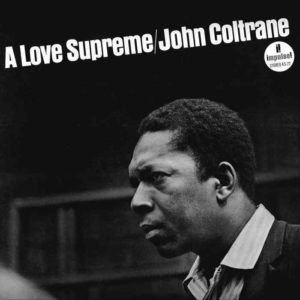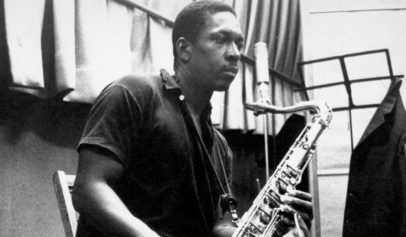
It is a magical piece of work, incredibly moving and impactful, displaying the many skills that made “Trane” probably the most celebrated saxophone player ever. While he had moved in previous years into the abstract sound that had come to be known as “free jazz,” a moody, atonal style that paid no attention to melody and gave the audience few hooks, “A Love Supreme” featured Coltrane’s return to a more-audience friendly approach—but still with some of the experimental elements that made him such a legend among many fellow musicians.
Coltrane struggled many years with a drug addiction, as did many of his fellow practitioners of bebop. And in fact it was his near overdose in 1957 to moved him into a period of deep spirituality and a closeness with God. It is this relationship that he explores and celebrates on “A Love Supreme.” The recording consists of four movements, with Coltrane actually chanting the words “A Love Supreme” in the first movement, signifying his love for God. In the sublime fourth movement, Coltrane plays the words of a religious poem that he included in the album’s liner notes. You can listen to him play along with the poem here on a YouTube recording.
The recording, made with bandmates that came to be known as the Classic Quartet—pianist McCoy Tyner, bassist Jimmy Garrison, and drummer Elvin Jones—was done in just one session on December 9, 1964 at the Van Gelder Studio in Englewood Cliffs,New Jersey, with engineer Rudy Van Gelder, for the Impulse! label.
While Coltrane records typically sold about 30,000 units, “A Love Supreme” had sold about 500,000 copies by 1970, which were big numbers for a jazz album. Amazingly, his quartet only played “A Love Supreme” one time to a live audience, on July 26, 1965, in a performance at the Festival Mondial du Jazz Antibes, in Juan-les-Pins, France. That recording was remastered and released in a 2002 two-CD set by Impulse!, along with the original album and additional studio outtakes.

By 1967 he was gone, dying of liver cancer at the age of 40, his body rebelling against the abuse to which he had subjected it over his short life.
But 50 years after it was created, “A Love Supreme” still sounds as fresh, inventive and magical as the day it was laid down in that New Jersey studio. Such is the power and beauty of music—the ability it gives an artist to communicate directly with an audience, a half century after he was taken away.
Many jazz experts say that “A Love Supreme” was the last great jazz recording, made just before the art form breathed its final breath as a dominant player on the American musical scene. Rock was about to overwhelm it, to electrify a generation of young people who considered jazz their parents’ music. But with “A Love Supreme” we can jump back to 1965, to hear a genius blow a masterpiece into his instrument.
Thank you, Trane.


